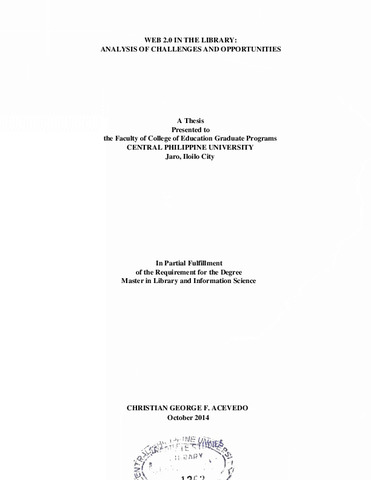Web 2.0 in the library: Analysis of challenges and opportunities
| dc.contributor.adviser | Alenzuela, Reysa | |
| dc.contributor.author | Acevedo, Christian George F. | |
| dc.coverage.spatial | Capiz | en_US |
| dc.date.accessioned | 2021-03-09T05:09:43Z | |
| dc.date.available | 2021-03-09T05:09:43Z | |
| dc.date.issued | 2014 | |
| dc.identifier.citation | Acevedo, C. G. F. (2014). Web 2.0 in the library: Analysis of challenges and opportunities (Unpublished Master's thesis). Central Philippine University, Jaro, Iloilo City. | en_US |
| dc.identifier.uri | https://hdl.handle.net/20.500.12852/577 | |
| dc.description | Full text available | en_US |
| dc.description.abstract | The study was conducted to explore the possibilities of integrating Web 2.0 tools in academic libraries of the Province of Capiz. This mix-method research utilized questionnaire and focus group discussion (FGD) in gathering data from 17 licensed librarians working in the higher education institutions of Capiz. Librarians’ level of awareness, competencies, and acceptance of Web 2.0 technologies were investigated. Existing Web 2.0 tools and availability of IT facilities in the libraries were also identified. Findings revealed that while there is a high level of awareness on common Web 2.0 tools, the librarians’ personal use of Web 2.0 tools such as social networking sites, instant messaging, wikis and video sharing, did not translate to the adoption and utilization of Web 2.0 tools in the library. Strong acceptance in the use of Web 2.0 tools was also found among librarians but majority of the respondents were not confident in using Web 2.0 tools. Thus, there is a need to develop librarians’ competencies in collaborative writing and in blogging. The libraries surveyed have the basic facilities and infrastructures to make Web 2.0 integration possible. The lack of maintenance for IT equipment, limited training, absence of plan for Web 2.0 integration and inadequate staff were identified as deterring factors. To address these challenges, the head librarians should include in its development plan strategies for improving IT maintenance, trainings, planning and staffing that will make Web 2.0 integration viable. The availability of funding, adequate facilities and supportive administration were identified as opportunities that should be capitalized for successful Web 2.0 integration in libraries. | en_US |
| dc.format.extent | xii, 131 leaves | en_US |
| dc.language.iso | en | en_US |
| dc.subject.ddc | GSL Theses 020.72 Ac37 | en_US |
| dc.subject.lcsh | Web 2.0 | en_US |
| dc.subject.lcsh | Academic libraries | en_US |
| dc.subject.lcsh | Academic librarians | en_US |
| dc.subject.lcsh | Philippines--Capiz (Province) | en_US |
| dc.subject.lcsh | Social networks | en_US |
| dc.subject.lcsh | Instant messaging | en_US |
| dc.subject.lcsh | Wikis and libraries | en_US |
| dc.subject.lcsh | Social media | en_US |
| dc.subject.lcsh | Web 2.0--Utilization | en_US |
| dc.subject.lcsh | Web 2.0--Use studies | en_US |
| dc.subject.lcsh | Awareness | en_US |
| dc.title | Web 2.0 in the library: Analysis of challenges and opportunities | en_US |
| dc.type | Thesis | en_US |
| dc.description.bibliographicalreferences | Includes bibliographical references | en_US |
| dc.contributor.chair | Pomado, Nelson A. | |
| dc.contributor.committeemember | David, Fely P. | |
| dc.contributor.committeemember | Gomez, Nida T. | |
| dc.contributor.committeemember | Alayon, Stephen | en |
| dc.contributor.department | School of Graduate Studies | en_US |
| dc.description.degree | Master of Library and Information Science | en_US |



